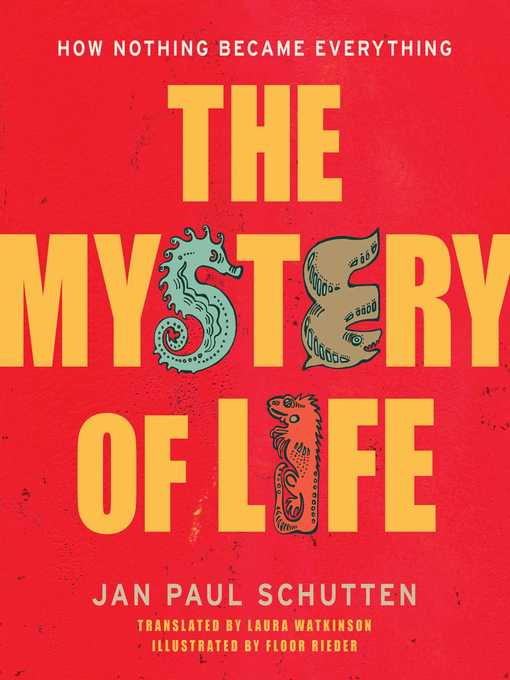
The Mystery of Life
How Nothing Became Everything
فرمت کتاب
ebook
تاریخ انتشار
2015
Lexile Score
830
Reading Level
4-5
ATOS
6.3
Interest Level
4-8(MG)
نویسنده
Floor Riederناشر
Aladdin/Beyond Wordsشابک
9781481429184
کتاب های مرتبط
- اطلاعات
- نقد و بررسی
- دیدگاه کاربران
نقد و بررسی

sushi321 - this book was so beautifully written!

July 13, 2015
“For millions of years, this planet has been teeming with life, all of which is made up of... lifeless atoms. That’s a marvel, isn’t it?” In a book originally published in the Netherlands, Schutten looks into the miracle of life, whether the specimen in question is a microscopic bacterium or an invented sample human, “Joe Schmo from Buffalo,” exploring the age of the planet, natural selection, and the development of life on Earth along the way. Rieder’s illustrations, seen in b&w by PW, echo the playful tone that Schutten often adopts (“Were Our Ancestors Slime Balls?” and “What’s So Great About Our Eyes?” represent typical question-driven section headers). It’s an offbeat but informative guide to life that introduces as many questions as it answers. Ages 10–14.

May 15, 2015
A lighthearted view of the universe's progress, from the Big Bang to the evolution of bacteria, bonobos-and "Joe Schmo from Buffalo." Returning continually to Mr. Schmo ("Jos Grootjes uit Driel" in the original Dutch) as his exemplar for Homo sapiens, Schutten starts simple-"Yes, even Lady Gaga is made up of atoms"-and proceeds from there. He explains how nonliving components combined to create living things of increasing complexity through evolution: "the greatest scientific idea of all time." Defining "life" (arguably) as anything that eats, reproduces, and dies, he offers thoughts on selected biological structures and processes from genetics ("Your genes are actually the boss of you") to how eyes developed and why it's such a good idea to have some separation between mouth and butt. Declaring himself an agnostic, he also takes swipes at both intelligent design arguments and creationism. Though his discussion of hiccups is blurred by fuzzy logic, and viruses and extinction events rate barely a mention, his overall account of life's origins and tenure is as rich in detail as it is entertaining. Rieder likewise supplies a flood of line drawings that provide humorous visual commentary as well as additional information.A glib and occasionally spotty picture but eminently readable and generally on target. (end references, index) (Nonfiction. 11-13)
COPYRIGHT(2015) Kirkus Reviews, ALL RIGHTS RESERVED.

June 1, 2015
Gr 5 Up-How old is the Earth, and how was it formed? How did nonliving atoms evolve into single cell organisms and then into the plethora of species that inhabit the Earth today? How did scientists discover the answers to these questions, and how can they provide proof for their theories? Schutten responds to these queries and countless others as he explains the scientific discoveries that led, over time, to the development of theories such as the big bang and evolution. Taking a big picture approach, he puts all the pieces of the puzzle that comprise our complex world into one accessible, entertaining title, using just the right mixture of fun facts, scientific information, and age-appropriate language. Schutten divides his chapters up into subsections that ask specific questions ("What Are Seashells Doing on Top of a Mountain?") and incorporates complex ideas in his responses. He also peppers his text with interesting tidbits of information. For example, we get goose bumps because our ancestors had fur-which, when it stood on end, provided warmth. Schutten is an award-winning author who argues vehemently for evolution but doesn't exclude those who believe in God and creationism; he encourages his readers to think for themselves. Interspersed liberally throughout the text are clear, rather playful illustrations, which add to the lighthearted and humorous tone. VERDICT A great choice for libraries looking to bolster their STEM collection.-Ragan O'Malley, Saint Ann's School, Brooklyn, NY
Copyright 2015 School Library Journal, LLC Used with permission.

September 15, 2015
Grades 5-9 Schutten attempts to demystify life on Earth. Beginning with a definition of life itself and such basics as cells, atoms, and bacteria, he makes progressive jumps in reasoning to explain how old the universe is, how the universe began, and how and where life on Earth began. The theory of evolution and natural selection fill the bulk of the book as he describes in detail how species adapted and changed over time. The author also acknowledges that evolution is a sensitive subject and respectfully pokes fun at both scientists and creationists. Conversational text, with Joe Schmo from Buffalo as a sample human, keeps the potentially weighty explanations easy to understand. While questions like How does a fish get four legs? drive the text, it's questions like How do you survive without a butt? that grab readers' attentions and get them thinking like scientists. Although some humor crosses into the unscientific, Schutten's evolutionary offering is more substantial than many books on the topic.(Reprinted with permission of Booklist, copyright 2015, American Library Association.)

























دیدگاه کاربران